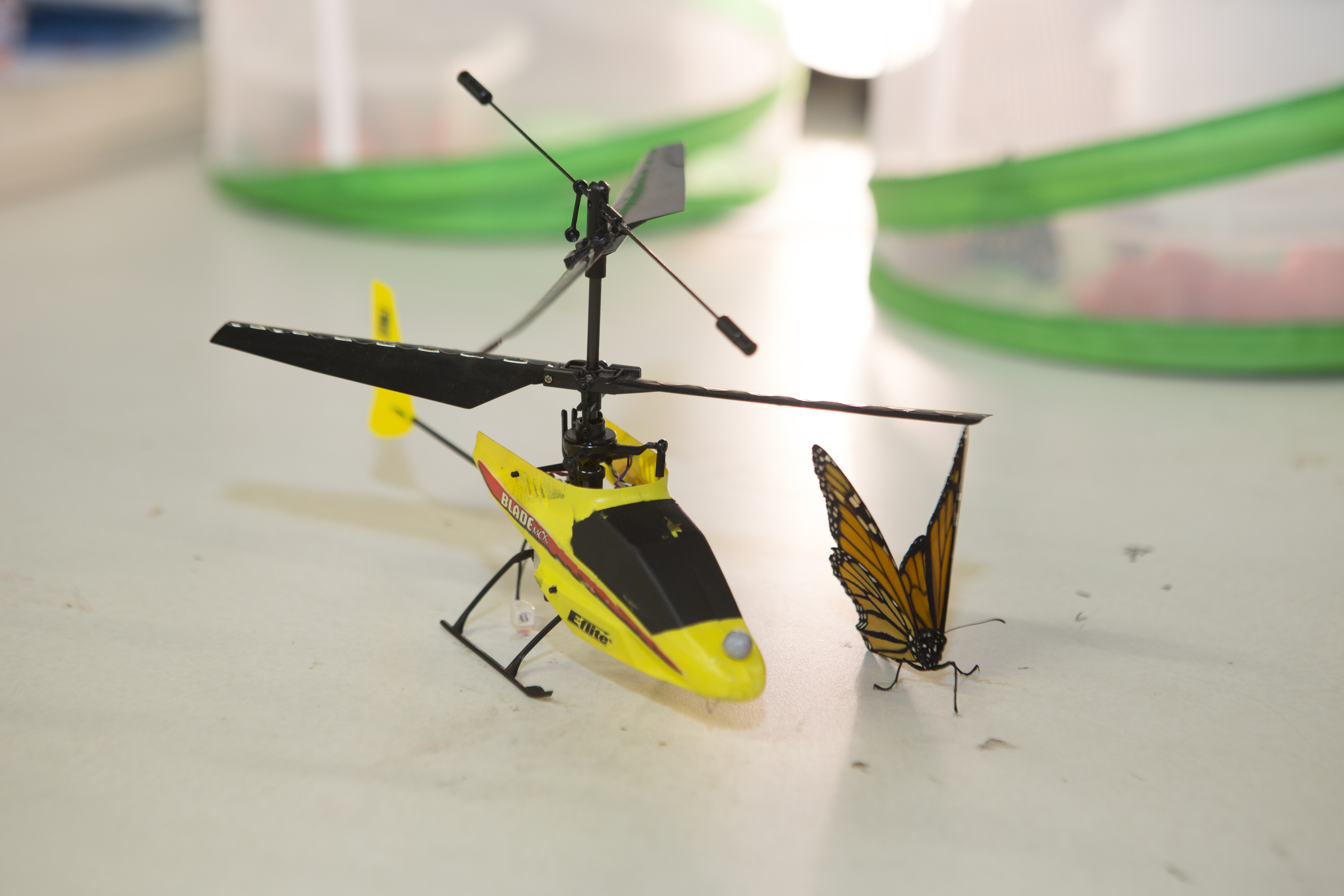By Adam Jones
Photos by Dennis Keim
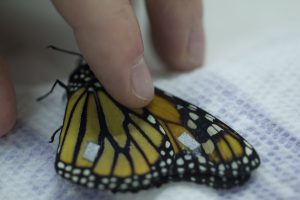
Fun fact: butterflies go into hibernation when they get cold. It helps them survive the winter.
Turns out, it also calms them when, for example, putting stickers the size of a baby’s fingernail on their wings and head. Of course, there are few people who have ever done this, but Jake Cranford is one.
“The markers are difficult to put on,” he says in a matter-of-fact understatement while performing the near surgery-like precision of sticking tiny adhesive markers to a butterfly. “You have to try and be delicate.”
His perseverance, though, will result in a motion-capture study of butterflies in flight that is part of a larger research effort led by Dr. Amy Lang an engineering faculty member at The University of Alabama.
Lang is examining the tiny scales on butterfly wings that help lift the insect despite its low speed during flight. Lang, who also works with shark scales, uses bio-inspired engineering, or biomimetics, to help improve the movement of flow over solid surfaces, specifically by altering the boundary where the air interacts with the moving surface, such as a butterfly wing. The study may lead to improved human-made flight, possibly crafting a way to improve micro aerial vehicles, or MAVs.
“As engineers, we are looking to nature for inspiration,” she says. “We have taken a complex situation and boiled it down to whether butterfly scales provide an aerodynamic benefit. If we understand the butterfly wing, there could be other applications.”
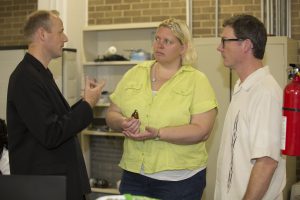
The scales covering butterfly and moth wings represent about 190 million years of natural selection for insect flight efficiency, with the monarch butterfly estimated to have appeared as recently as 250,000 years ago, scientists say. Evolutionary adaptations in the structure of the scales appear to have led to a unique micro-pattern that reduces drag and likely increases thrust and lift during flapping and gliding flight.
“The shape of wing scales may represent an evolutionary adaptation for better or more efficient flight,” says Dr. John Yoder, a UA biologist. “If your life cycle depends on flying to your next meal or mating session, you won’t make it very long if you can’t do that.”
Yoder is working with Lang on the project. In his lab, electron microscopes are used to study the scales on the butterfly wings that help create models used for testing in Lang’s liquid-flow tank. Yoder and his students are also looking at the difference in the arrangement and shape of scales between migratory butterflies, such as a monarch, and short range butterflies, such as the Mourning Cloak.
One scale on a butterfly wing is as small as a tenth of a millimeter. Arranged like shingles on a roof, the scales stick up slightly, trapping a ball of air under the scale and allowing air to flow smoothly over it, Lang says. But air traveling in the perpendicular direction could lead to increased drag. Thus the wing may be optimally patterned for the air to interact with the wing for optimal force production.
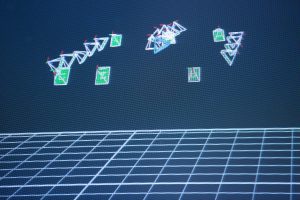
Despite myth, butterflies can fly without the scales, but initial testing showed it requires more flapping for the insect to remain in the air. As part of the research, monarch butterflies with scales and those with scales brushed off flew in an optical tracking facility at the University of Alabama in Huntsville directed by Dr. Nathan Slegers, a former engineering professor at UAH.
The lab used high-speed video of a monarch in flight to show that the same butterfly without its scales flapped its wings about 10 percent more to maintain the same flight.
“This reduced energy expended during flight would be important to the monarch, which has the longest migration of any insect,” Lang says.
Cranford, a master’s student under Slegers at UAH, is in charge of the effort to wake up refrigerated butterflies, place seven reflective markers on them and get them to fly in front of a bank of infrared cameras.
The flapping butterflies were tracked by the cameras, turning their flight path into a computer animation. It’s the same technology used to turn actors into animated characters such as Iron Man and The Hulk from the recent “The Avengers” films, except the butterflies are used to create data for Lang to pore over.
Besides live butterflies, Lang and her student study clipped wings and models of butterfly-inspired geometries about 10 to 100 times larger than real scales. Experiments in the lab will test how butterfly scales improve airflow.
“The flow over a butterfly wing is very complex, but when it flaps, it forms a leading-edge vortex that helps it get lift,” Lang says. “We think the scales allow the butterfly to flap a little bit slower and get the same results.”
Lang also works with Dr. Will Schreiber, a UA engineering colleague, who is studying dynamic flow over the butterfly scales through computer simulations.
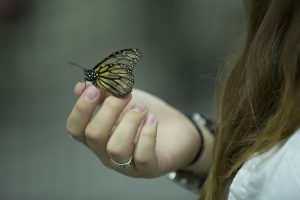
Schreiber boiled down the complexity of simulating air flow through microscopic channels created by the scales on the insect’s wing into a mathematical model for study. This should lead to an understanding of how the micro-configuration of a surface can affect fluid flow over that surface, helping determine how to manipulate the surface to reduce the drag over it.
“Ultimately, of course, the goal of the project is more than looking at butterflies,” Schreiber says. “But by studying butterflies, maybe we can come up with knowledge that can be applied to an engineering design such as an aircraft which requires less fuel to make its journey.”
Modeled scales placed on man-made wings could improve airflow in micro aerial vehicles, or MAVs, miniature, unmanned, aerial robots primarily used for military reconnaissance and surveillance purposes. With bio-inspired geometries on its wings, MAVs could carry a larger payload or use less fuel. Lang speculates that future solar cells, modeled after butterfly scales on wings, could one day provide energy and improve flight.
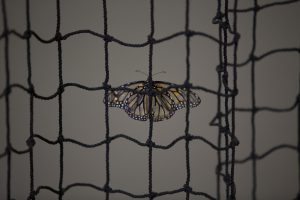
For now, though, Lang hopes to fundamentally understand the advantages a butterfly gets from the scales on its wings.
“Innovations in the field of boundary layer control are needed to provide efficient methodologies to decrease drag and improve efficiency,” she says.
The study is funded by the National Science Foundation.
Dr. Lang is an associate professor of aerospace engineering and mechanics. Dr. Yoder is an associate professor of biological sciences in UA’s College of Arts and Sciences, and Dr. Schreiber is an associate professor of mechanical engineering.
